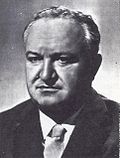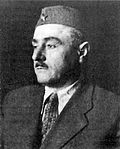| President of the League of Communists of Croatia | |
|---|---|
| Serbo-Croatian: Predsjednik Saveza komunista Hrvatske | |
  Emblems of the LCY | |
| Type | Party leader |
| Member of | LCY Presidency and SRC Presidency |
| Appointer | Central Committee |
| Term length | Two years, non-renewable (1982–1991) |
| Constituting instrument | LCY Charter & LCC Charter |
| Formation | 1 August 1937 |
| First holder | Đuro Špoljarić |
| Final holder | Ivica Račan |
| Abolished | 3 November 1990 |
The president was the leader of the League of Communists of Croatia (LCC), the ruling party of the Socialist Republic of Croatia (SRC) in the Socialist Federal Republic of Yugoslavia. Party rules stipulated that the LCC Central Committee elected the president. Moreover, the Central Committee was empowered to remove the president. The president served ex officio as a member of the Presidency of the Central Committee of the League of Communists of Yugoslavia (LCY) and of the SRC Presidency. To be eligible to serve, the president had to be a member of the Presidency of the LCC Central Committee. The 9th LCC Congress instituted a two-year term limits for officeholders.
Contents
The office traces its lineage back to the office of "Political Secretary of the Provincial Committee of the Communist Party of Yugoslavia in Croatia," established after the founding of the LCY in 1919. This body had no distinct rights and was under the jurisdiction of the Yugoslav Central Committee. On 1 August 1937, the LCY convened the founding congress of the Communist Party of Croatia. On 2 August, the Central Committee of the 1st Congress elected Đuro Špoljarić as "Political Secretary of the Central Committee of the Communist Party of Croatia". The LCY 6th Congress on 2–7 November 1952, renamed the party League of Communists, and the Croatian republican branch followed suit and changed its name to League of Communists of Croatia. On 4 October 1966, the 5th Plenary Session of the Central Committee of the LCY 8th Congress abolished the office of General Secretary at the national level and replaced with the office of President. The LCC Central Committee convened a meeting on 26 October 1966 that abolished the office of secretary and established the "President of the Central Committee of the League of Communists of Croatia". The reforms passed by the LCY Central Committee plenum strengthened the powers of the republican branches and gave more powers to the Croatian party leader. The 9th LCC Congress introduced another set of reforms on 16 May 1982, which abolished the existing office and replaced it with the "President of the Presidency of the Central Committee of the League of Communists of Croatia". This office was retained until 3 November 1990, when the party changed its name to the Party of Democratic Changes.










